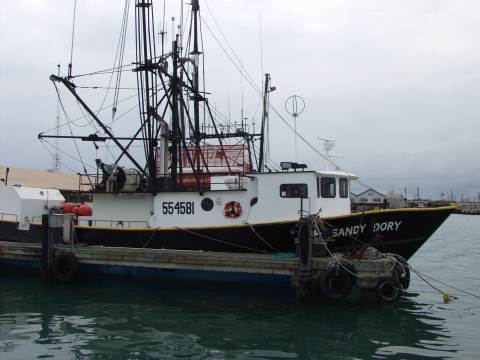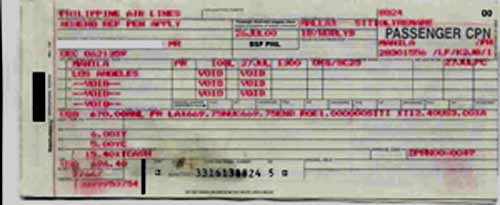
Immediately after Judge David Ezra rendered his decision requiring the National Marine Fisheries Service to provide 100% observer coverage aboard Hawaii longline fishing vessels the public was told by the Western Pacific Fisheries Council, the Longline Association and others that his ruling would have a devastating impact on the local economy and local jobs. We decided to take a look at some of the jobs affected by the ruling and found some interesting information.
|
|
WHO’S FISHING
As reported in the July 2000 issue of Hawaii Fishing News, we heard from anonymous sources that some of the Hawaii-based longline boat owners were importing crews from the Philippines to avoid paying American crews a percentage of the total catch. Supposedly the workers are flown in and taken directly to the boats where they immediately depart for fishing. As we also reported in HFN, we sent a letter to Mr. Jim Cook, an owner of several longline boats as well as Chairman of the Western Pacific Fisheries, asking questions about this. At the time Cook refused to either confirm or deny the information. However after going to press in July Mr. Cook told us he knew Hawaii-based boats employed approximately 50 to 60 workers from the Philippines as crew members.
We telephoned Deputy Director David Gulick, of the United States Department of Justice, Immigrations and Naturalization Service, Honolulu, to get more information on legality and provide him with what we found. He denied knowing anything about the use of Filipino nationalists aboard Hawaii-based longline boats, saying that he had not received any letters, phone calls or other information on the subject. He went on to tell us he had received a call from someone in the longline industry who informed him they were importing workers from the Philippines to work on foreign boats in American Samoa, but vehemently denied his agency knew anything about the use of imported workers aboard Hawaii-based boats. He also refused to put in a request for his agency to conduct an investigation, repeating once again that "imported crews are only working on foreign vessels, not American vessels. If they were working aboard American vessels in U.S. waters the vessel and crew would be illegal".
ON THE WATERFRONT
After that we decided to go down to the waterfront to investigate Jim Cook’s statement. Our first attempt left us empty handed and knowing less than we originally knew. However, with patience we were able to find some interesting information regarding the use of imported workers aboard Hawaii-based longline boats.
While on the pier I started talking with a man working on one of the boat's mooring lines. I asked him if he crewed aboard the boat while it was out fishing. He told me yes, he was part of the crew and that they were cleaning the boat in preparation to go fishing. He said that he and the four other crew members were from the Philippines. He also said the owner of the vessel pays the cook and the boatsman $400.00 per month, the other, lesser experienced crew $385.00 a month, and those without experience $300.00 a month. Each crew member also receives a bonus of $10.00 per ton of fish, and when the captain sold shark fins he divided up the money amongst the five members of the crew. He told me the Captain sold fins as recently as July 26, 2000 and that the crew is always paid in cash.
As we talked I learned that crew members are "contracted" in the Philippines. To get to Hawaii he and the others flew from Manila to Los Angeles, California and then caught another plane from Los Angeles to Honolulu. He said they came through Los Angeles because their local agent knew someone at the airport in L.A. He told me the boat captain paid their airfare and their local agent picked them up at the airport and drove them to the boats.
We obtained airline receipts from one of the crew members. The receipts indicate that on July 27, 2000, the crewman traveled from Manila, Philippines, to Los Angeles aboard Philippines Airlines flight 108L arriving at Los Angeles at 1300 hours. The cost of the ticket in United States dollars was $ 696.40. On July 27, 2000, he traveled from Los Angeles, California to Honolulu, Hawaii, aboard United Airlines flight 558 arriving at Honolulu at 1440 hours. The cost for that ticket in United States dollars was $ 577.83.

IMPORT/EXPORT
We were also shown a business card for their agent, PIN Pescadores Int., located in Quezon City, 110 Philippines. The card identified a resident of Waipahu, HI, as their Hawaii-based representative, or local agent. We telephoned the agent who told us the following:The business is in the Philippines. To obtain crew the boat owners provides proof of insurance, boat documents, and the name of their boat captains. She faxes the information to the main office in the Philippines. "After that they will give the captain a contract for signing. This process takes approximately 2 to 3 weeks". Her company gets the visas and the boat owner pays for the airlines tickets for the crew. She then told us "the crew would come from Manila via Los Angeles and from Los Angeles they will catch a flight to Hawaii because the immigrations and customs is more stricter in Honolulu, especially with American boats. They ask questions because they don’t want foreign people to come to Hawaii because they are saying that they are losing jobs locally".
She then told us, "Right now we have 27 boats some of them with a crew of five. The boat owners give the crew bonuses of 10 dollars per ton to each crew member. The owner pays the main office in Manila a finders fee of $100 dollars per crew member". She also admitted that the owners paid the crew with money recovered from the sale of shark fins.
We were able to document imported workers aboard several other longline fishing boats. Some of the boats were being serviced by two other companies; California Sealink Inc. operating out of Carson, California, and Manila Sealink, Inc. Intramuros, Manila, Philippines. After speaking with other crew members we determined that both companies were operated in the same way as Pin Pescaderos Int.
Basically a typical stay for a crew member is six months to a year. The imported crew members cannot leave their vessel for any reason during the length of their contract. They are confined to a small space on a vessel which, as we have seen from recently published observer reports, is in many cases less than adequate for long-term habitation, particularly if you can’t come ashore.
WHERE’S THE LAW
During our research we uncovered documents that contradicted Deputy Director Gulick’s claim his agency did not know that Hawaii-based longliners were using imported workers to serve as crew members aboard fishing vessels. A U.S. Department of Justice, Immigrations and Naturalization Service Form I-259, completed by an INS officer, shows that on 6/19/2000 the officer visited the longline fishing vessel Edward G for the following reasons: "Alien crew aboard U.S. based (ported) U.S. Flag vessel.". The form also indicated that the visa types were C1 and D. The officer’s actions appear to contradict federal law. We were able to obtain Code of Federal Regulations that spoke specifically to the use of Non-resident aliens aboard United States-based fishing vessels, section 23.16 "Nonresident aliens may not be employed aboard any U.S. based fishing vessel as "D"crew members. An alien seeking permission to land as a "D" crew member should not be detained onboard, unless parole is warranted".
The Edward G is part of a fleet working in Hawaii owned and operated by Edward G Co. Inc., 10 W. Seventh Street. Barnegat Light, New Jersey. It is 77.9 ft long with a hull depth of 11.9 ft. and hull breadth of 24 ft. Other vessels in the fleet, owned by various companies at the same New Jersey address, are the Kelly Ann (77.9'), Sandy Dory (62.1'), Lady Alice (84'), and the Gail Ann (92'). (Note: the previous name of the Gail Ann was Mr. Piti.....). This information was obtained from a declaration submitted to the courts by the National Marine Fisheries Service and Coast Guard vessel documentation. I contacted both the owner and the captain of the Edward G but they did not return my calls.
 |
THIS IS NOT A CRUISE
Judge Ezra’s ruling has allowed us to see the ugly side of America. The boat owners claim they cannot find workers in Hawaii and when they do manage to find locals that want to work they don’t have the experience. They say the contract crews were living in poverty in their homeland so they are more than happy to work for low wages aboard their boats. They also say crews from the Philippines are superior workers. If that is the case what is the justification for paying them substandard wages and subjecting them to inadequate living conditions?
I guess we shouldn’t be too shocked or surprised that some members of the longline industry and the Western Pacific Regional Management Council would participate or condone the practice of confining human beings to a small boat for a year or more. We have to keep in mind that these are the same people that orchestrated a mudslinging campaign against Judge Ezra’s ruling. It appears the only thing they didn’t do in their negative campaign was to burn the American flag in the name of saving local jobs.
Is the Hawaii longline fisheries just another sweat shop for foreign workers? Hiring imported workers and subjecting them to inhumane conditions is an affront to our humanity. What is more puzzling is operators of sweatshops in the garment industry in California and other states are arrested and prosecuted for subjecting workers to inhumane conditions but the INS is denying similar practices are occurring in Hawaii. We recently received a call from Mr. Gulick’s supervisor saying they will meet with us in the near future to determine if our findings warrant an investigation. Let us hope that this deplorable situation can be corrected.